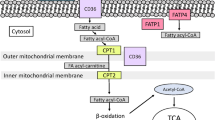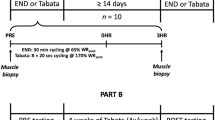Abstract
The purpose of this study was to examine the relationship between skeletal muscle monocarboxylate transporters 1 and 4 (MCT1 and MCT4) expression, skeletal muscle oxidative capacity and endurance performance in trained cyclists. Ten well-trained cyclists (mean ± SD; age 24.4 ± 2.8 years, body mass 73.2 ± 8.3 kg, VO2max 58 ± 7 ml kg−1 min−1) completed three endurance performance tasks [incremental exercise test to exhaustion, 2 and 10 min time trial (TT)]. In addition, a muscle biopsy sample from the vastus lateralis muscle was analysed for MCT1 and MCT4 expression levels together with the activity of citrate synthase (CS) and 3-hydroxyacyl-CoA dehydrogenase (HAD). There was a tendency for VO2max and peak power output obtained in the incremental exercise test to be correlated with MCT1 (r = −0.71 to −0.74; P < 0.06), but not MCT4. The average power output (P average) in the 2 min TT was significantly correlated with MCT4 (r = −0.74; P < 0.05) and HAD (r = −0.92; P < 0.01). The P average in the 10 min TT was only correlated with CS activity (r = 0.68; P < 0.05). These results indicate the relationship between MCT1 and MCT4 as well as cycle TT performance may be influenced by the length and intensity of the task.
Similar content being viewed by others
References
Bentley DJ, Newell J, Bishop D (2007) Incremental exercise test design and analysis: implications for performance diagnostics in endurance athletes. Sports Med 37(7):575–586. doi:10.2165/00007256-200737070-00002
Bertucci W, Duc S, Villerius V, Pernin JN, Grappe F (2005) Validity and reliability of the PowerTap mobile cycling powermeter when compared with the SRM device. Int J Sports Med 26(10):868–873. doi:10.1055/s-2005-837463
Bishop D, Jenkins DG, McEniery M, Carey MF (2000) Relationship between plasma lactate parameters and muscle characteristics in female cyclists. Med Sci Sports Exerc 32(6):1088–1093. doi:10.1097/00005768-200006000-00008
Bishop D, Edge J, Thomas C, Mercier J (2007) High-intensity exercise acutely decreases the membrane content of MCT1 and MCT4 and buffer capacity in human skeletal muscle. J Appl Physiol 102(2):616–621. doi:10.1152/japplphysiol.00590.2006
Bishop DJ, Edge J, Thomas C, Mercier J (2008) Effects of high-intensity training on muscle lactate transporters and post-exercise recovery of muscle lactate and hydrogen ions in women. Am J Physiol Regul Integr Comp Physiol [Epub ahead of print]
Borges O, Essén-Gustavsson B (1989) Enzyme activities in type I and II muscle fibres of human skeletal muscle in relation to age and torque development. Acta Physiol Scand 136(1):29–36. doi:10.1111/j.1748-1716.1989.tb08626.x
Chapman AR, Vicenzino B, Blanch P, Hodges PW (2007) Leg muscle recruitment during cycling is less developed in triathletes than cyclists despite matched cycling training loads. Exp Brain Res 181(3):503–518. doi:10.1007/s00221-007-0949-5
Clark SA, Aughey RJ, Gore CJ, Hahn AG, Townsend NE, Kinsman TA, Chow CM, McKenna MJ, Hawley JA (2004) Effects of live high, train low hypoxic exposure on lactate metabolism in trained humans. J Appl Physiol 96(2):517–525. doi:10.1152/japplphysiol.00799.2003
Coyle EF, Coggan AR, Hopper MK, Walters TJ (1988) Determinants of endurance in well-trained cyclists. J Appl Physiol 64(6):2622–2630
Coyle EF, Feltner ME, Kautz SA, Hamilton MT, Montain SJ, Baylor AM, Abraham LD, Petrek GW (1991) Physiological and biomechanical factors associated with elite endurance cycling performance. Med Sci Sports Exerc 23(1):93–107. doi:10.1249/00005768-199101000-00015
Coyle EF, Sidossis LS, Horowitz JF, Beltz JD (1992) Cycling efficiency is related to the percentage of type I muscle fibers. Med Sci Sports Exerc 24(7):782–788. doi:10.1249/00005768-199207000-00008
Duffield R, Dawson B, Pinnington HC, Wong P (2004) Accuracy and reliability of a Cosmed K4b2 portable gas analysis system. J Sci Med Sport 7(1):11–22. doi:10.1016/S1440-2440(04)80039-2
Farrell PA, Wilmore JH, Coyle EF, Billing JE, Costill DL (1979) Plasma lactate accumulation and distance running performance. Med Sci Sports 11(4):338–344
Foster C, Costill DL, Daniels JT, Fink WJ (1978) Skeletal muscle enzyme activity, fibre composition and VO2max in relation to distance running performance. Eur J Appl Physiol 39:73–80. doi:10.1007/BF00421711
Garcia CK, Goldstein JL, Pathak RK, Anderson RG, Brown MS (1994) Molecular characterization of a membrane transporter for lactate, pyruvate, and other monocarboxylates: implications for the Cori cycle. Cell 76(5):865–873
Gardner AS, Stephens S, Martin DT, Lawton E, Lee H, Jenkins D (2004) Accuracy of SRM and power tap power monitoring systems for bicycling. Med Sci Sports Exerc 36(7):1252–1258. doi:10.1249/01.MSS.0000132380.21785.03
Halestrap AP, Price NT (1999) The proton-linked monocarboxylate transporter (MCT) family: structure, function and regulation. Biochem J 343(Pt 2):281–299. doi:10.1042/0264-6021:3430281
Hardin DS, Azzarelli B, Edwards J, Wigglesworth J, Maianu L, Brechtel G, Johnson A, Baron A, Garvey WT (1995) Mechanisms of enhanced insulin sensitivity in endurance-trained athletes: effects on blood flow and differential expression of GLUT 4 in skeletal muscles. J Clin Endocrinol Metab 80(8):2437–2446. doi:10.1210/jc.80.8.2437
Holloszy JO, Coyle EF (1984) Adaptations of skeletal muscle to endurance exercise and their metabolic consequences. J Appl Physiol 56(4):831–838
Horowitz JF, Sidossis LS, Coyle EF (1994) High efficiency of type I muscle fibers improves performance. Int J Sports Med 15(3):152–157. doi:10.1055/s-2007-1021038
Ivy JL, Withers RT, Van Handel PJ, Elger DH, Costill DL (1980) Muscle respiratory capacity and fiber type as determinants of the lactate threshold. J Appl Physiol 48(3):523–527
Juel C (1996) Lactate/proton co-transport in skeletal muscle: regulation and importance for pH homeostasis. Acta Physiol Scand 156(3):369–374. doi:10.1046/j.1365-201X.1996.206000.x
Larsson L, Karlsson J (1978) Isometric and dynamic endurance as a function of age and skeletal muscle characteristics. Acta Physiol Scand 104(2):129–136. doi:10.1111/j.1748-1716.1978.tb06259.x
Messonnier L, Kristensen M, Juel C, Denis C (2007) Importance of pH regulation and lactate/H+ transport capacity for work production during supramaximal exercise in humans. J Appl Physiol 102(5):1936–1944. doi:10.1152/japplphysiol.00691.2006
McCullagh KJA, Poole RC, Halestrap AP, O’Brien M, Bonen A (1996) Role of the lactate transporter (MCT1) in skeletal muscles. Am J Physiol 271:E143–E150
Pilegaard H, Terzis G, Halestrap A, Juel C (1999) Distribution of lactate/H+ transporter isoforms MCT1 and MCT4 in human skeletal muscle. Am J Physiol 276:E843–E848
Pyne DB, Boston T, Martin DT, Logan A (2000) Evaluation of the Lactate Pro blood lactate analyser. Eur J Appl Physiol 82(1–2):112–116. doi:10.1007/s004210050659
Sjodin B, Jacobs I, Karlsson J (1981) Onset of blood lactate accumulation and enzyme activities in m. vastus lateralis in man. Int J Sports Med 2:166–170. doi:10.1055/s-2008-1034605
Srere P (1969) Citrate synthase. Methods Enzymol 13:3–5. doi:10.1016/0076-6879(69)13005-0
Tesch PA, Sharp DS, Daniels WL (1981) Influence of fibre type composition and capillary density on onset of blood lactate accumulation. Int J Sports Med 2:252–255. doi:10.1055/s-2008-1034619
Thomas C, Perrey S, Lambert K, Hugon G, Mornet D, Mercier J (2005) Monocarboxylate transporters, blood lactate removal after supramaximal exercise, and fatigue indexes in humans. J Appl Physiol 98(3):804–809. doi:10.1152/japplphysiol.01057.2004
Weston AR, Myburgh KH, Lindsay FH, Dennis SC, Noakes TD, Hawley JA (1997) Skeletal muscle buffering capacity and endurance performance after high-intensity interval training by well-trained cyclists. Eur J Appl Physiol 75:7–13. doi:10.1007/s004210050119
Weston AR, Karamizrak O, Smith A, Noakes TD, Myburgh KH (1999) African runners exhibit greater fatigue resistance, lower lactate accumulation, and higher oxidative enzyme activity. J Appl Physiol 86(3):915–923
Wilson MC, Jackson VN, Heddle C, Price NT, Pilegaard H, Juel C, Bonen A, Montgomery I, Hutter OF, Halestrap AP (1998) Lactic acid efflux from white skeletal muscle is catalyzed by the monocarboxylate transporter isoform MCT3. J Biol Chem 273(26):15920–15926
Acknowledgments
This study was financially supported by grants from the International Olympic Committee, the French Ministry of Sport and faculty (Medicine) research grants University of NSW, Sydney, Australia.
Author information
Authors and Affiliations
Corresponding author
Rights and permissions
About this article
Cite this article
Bentley, D.J., Roels, B., Thomas, C. et al. The relationship between monocarboxylate transporters 1 and 4 expression in skeletal muscle and endurance performance in athletes. Eur J Appl Physiol 106, 465–471 (2009). https://doi.org/10.1007/s00421-009-1034-5
Accepted:
Published:
Issue Date:
DOI: https://doi.org/10.1007/s00421-009-1034-5




